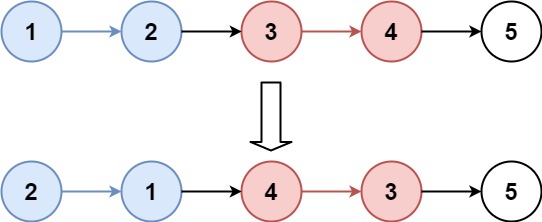Given the head of a linked list, reverse the nodes of the list k at a time, and return the modified list.
k is a positive integer and is less than or equal to the length of the linked list. If the number of nodes is not a multiple of k then left-out nodes, in the end, should remain as it is.
You may not alter the values in the list’s nodes, only nodes themselves may be changed.
Example 1:

Input: head = [1,2,3,4,5], k = 2 Output: [2,1,4,3,5]
Example 2:

Input: head = [1,2,3,4,5], k = 3 Output: [3,2,1,4,5]
Constraints:
- The number of nodes in the list is
n. 1 <= k <= n <= 50000 <= Node.val <= 1000
Java Solution
class ListNode {
int val;
ListNode next;
ListNode(int val) {
this.val = val;
}
}
public class ReverseKGroup {
public ListNode reverseKGroup(ListNode head, int k) {
if (head == null || k == 1) {
return head;
}
ListNode dummy = new ListNode(0);
dummy.next = head;
ListNode prevGroupEnd = dummy;
int count = 0;
ListNode current = head;
// Count the number of nodes in the list
while (current != null) {
count++;
current = current.next;
}
while (count >= k) {
ListNode groupStart = prevGroupEnd.next;
ListNode groupEnd = groupStart;
// Reverse k nodes in the current group
for (int i = 1; i < k; i++) {
ListNode nextNode = groupEnd.next;
groupEnd.next = nextNode.next;
nextNode.next = groupStart;
groupStart = nextNode;
}
prevGroupEnd.next = groupStart;
prevGroupEnd = groupEnd;
count -= k;
}
return dummy.next;
}
// Helper method to print the linked list
public void printList(ListNode head) {
while (head != null) {
System.out.print(head.val + " ");
head = head.next;
}
System.out.println();
}
public static void main(String[] args) {
// Example 1
ListNode head1 = new ListNode(1);
head1.next = new ListNode(2);
head1.next.next = new ListNode(3);
head1.next.next.next = new ListNode(4);
head1.next.next.next.next = new ListNode(5);
int k1 = 2;
ReverseKGroup solution = new ReverseKGroup();
ListNode result1 = solution.reverseKGroup(head1, k1);
System.out.print("Example 1 Output: ");
solution.printList(result1);
// Example 2
ListNode head2 = new ListNode(1);
head2.next = new ListNode(2);
head2.next.next = new ListNode(3);
head2.next.next.next = new ListNode(4);
head2.next.next.next.next = new ListNode(5);
int k2 = 3;
ListNode result2 = solution.reverseKGroup(head2, k2);
System.out.print("Example 2 Output: ");
solution.printList(result2);
}
}
This program defines a ListNode class representing a node in the linked list and a ReverseKGroup class with the reverseKGroup method to reverse the nodes in groups of size k. The printList method is a helper method to print the linked list. The main method demonstrates how to use the program with the provided examples.
Python Solution
class ListNode:
def __init__(self, val=0, next=None):
self.val = val
self.next = next
class ReverseKGroup:
def reverseKGroup(self, head, k):
if not head or k == 1:
return head
dummy = ListNode(0)
dummy.next = head
prev_group_end = dummy
count = 0
current = head
# Count the number of nodes in the list
while current:
count += 1
current = current.next
while count >= k:
group_start = prev_group_end.next
group_end = group_start
# Reverse k nodes in the current group
for _ in range(1, k):
next_node = group_end.next
group_end.next = next_node.next
next_node.next = group_start
group_start = next_node
prev_group_end.next = group_start
prev_group_end = group_end
count -= k
return dummy.next
# Helper method to print the linked list
def print_list(self, head):
while head:
print(head.val, end=" ")
head = head.next
print()
# Example usage:
# Example 1
head1 = ListNode(1, ListNode(2, ListNode(3, ListNode(4, ListNode(5)))))
k1 = 2
solution = ReverseKGroup()
result1 = solution.reverseKGroup(head1, k1)
print("Example 1 Output:", end=" ")
solution.print_list(result1)
# Example 2
head2 = ListNode(1, ListNode(2, ListNode(3, ListNode(4, ListNode(5)))))
k2 = 3
result2 = solution.reverseKGroup(head2, k2)
print("Example 2 Output:", end=" ")
solution.print_list(result2)
This Python code mirrors the Java solution. It defines a ListNode class for representing a node in the linked list and a ReverseKGroup class with the reverseKGroup method to reverse the nodes in groups of size k. The print_list method is a helper method to print the linked list. The example usage section demonstrates how to use the program with the provided examples.
